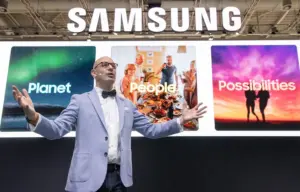I have been to CES, DisplayWeek and IFA this year, mostly looking at big screen solutions. The prospects for TVs seem a bit unclear, however. Some established brands continue to focus and innovate while other brands are retreating to more “me too” products. Below is a high-level summary of some key takeaways. You can view all the news videos in the IFA 2023 playlist on Insight Media’s YouTube channel.
In a presentation I gave in a meeting room, it summarized the state of the TV market based on data from Omdia, DSCC and Furturesource. The bottom line is that only larger screen sizes and TVs with advanced features offer much interest as they support new technologies and offer the best opportunity for profits. That’s not a revelation, but it seems clearer that anything under 55” is now a commodity product. And the focus is shifting to 75” and larger – at least for the enthusiastic leaders.
Samsung continues to lead but seems to be shifting its focus from 8K to larger screen sizes. Highlights include their 89” microLED TV that is now a production product. They revealed new details on its fabrication that illustrates the tremendous engineering effort that went into this. While still ridiculously expense, I now view this as the new gold standard in microLED TVs. They also showed how a modified QD-OLED TV can display colors outside of DCI-P3, which should excite content creators.
At Hisense, I really liked their 8K LaserTV. This is an ultra-short-throw projector with integrated screen and full TV OS. It is driven by a 3-laser system to achieve about 90% of BT-2020 and will soon launch in China for the equivalent of $20K, a very attractive price point for the custom install channel. They also impressed with their ULED X line of TVs that use a deep black panel and custom picture processing with top models offer 3000 nits and 2000 zones.
TCL blew away attendees with their 115” LED TV with 5000 nits and 5000 dimming zones. This will actually be commercialized in China but a 98” version will be offered too. In fact, TCL will offer 4 models at 98” with the entry model offering global dimming for around 2500 Euros. At that price, it is very attractive for commercial applications as well.
Sharp highlighted their TVs with a focus on miniLED TVs offering three different series. The top-of-the-line series offers 2000 zones and 2000 nits with quantum dots and 144 Hz panels.
Metz, Konka, Panasonic, Vestel, Toshiba, and Changhong all showed TVs on the show floor but did not really push picture quality or performance much. What seems to be shaping up among these brands is more of a TV O/S battle. Many of these brands now offer 2, 3, 4 or even 5 different TV operating systems. That often means Linux, Android TV, TiVo, and Roku at the entry level, stepping up to Google TV, VIDAA, or a home-grown OS like MyHomeScreen, with Tizen, FireTV, and WebOS being additional higher-end options. The idea is to offer TV/OS combinations to meet the needs of certain demographics.
Other brands were clearly downplaying their TVs. Haier and LG had exactly three TVs in their expansive booths. Loewe and TP Vision were in small trucks that were virtually invisible. Sony was a no show and Philips did a TV line review for the media only off the show floor.
I also saw several companies that are either TV or OEM/ODM brands. HKC falls into this latter category. HKC is a large panel maker, but they were showing a range of TV models, which was news to me. Other companies I saw were SmartTech, Stream and Skytech.
The TV business has historically been the prestige consumer electronics category, but the profitability of the segment is very challenging for most players. It now seems the luster of TVs may be wearing off for all but a few leaders.

